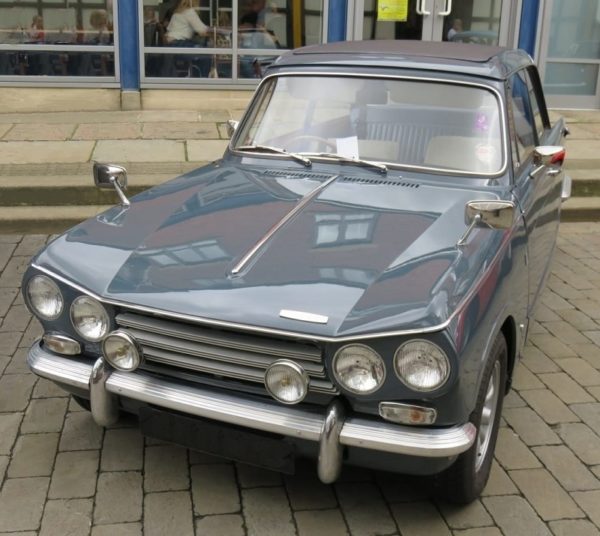
Vitesse is an apt name for this car. It was based on the well-known and much-loved Triumph Herald introduced in 1959 – but replacing the Herald’s 4-cylinder engine with a 6-cylinder powerplant transformed its performance and made it into a car with a far more sporting character.. Both the Herald and the Vitesse were styled by Giovanni Michelotti and both were always 2-doors. The slanted twin headlamps of the Vitesse are the simplest way to distinguish it from the Herald.
The engine was a 1596 cc version of that used in the Standard Vanguard Six but was fitted with twin carburettors. The gearbox was significantly strengthened from that of the Herald and was available with optional Laycock De Normanville overdrive that gave more relaxed and economical cruising. A convertible version was produced, and a curious advantage of the old-fashioned use of a separate chassis was that reinforcement for the convertible was unnecessary – apart from additional door catches to stop the doors opening during hard cornering. A sporting car indeed.
The Vitesse captured the imagination of British motorists – especially those looking for a sporting car with room for a family. It had a well-appointed interior (superior to that of the Herald), good fuel economy and a fine turn of speed. Better still, the convertible was virtually unique in the British marketplace as a four-seat convertible.
In 1966 the Vitesse was given even more performance by an increase in capacity to 1998 cc and was relaunched as the Vitesse 2-litre with power raised to 95 bhp, a far cry from the original 70 bhp of the first versions.
The final embodiment of the Vitesse came in October 1968 with the Mark II, with much-improved wishbone rear suspension that went some way to taming the unruly handling caused by the original swing axle set-up. Power rose once again, this time to 104 bhp, making 100 mph a reality at last. Our Snapshot is of one of these final versions – identified by the removal from the bonnet of the individual TRIUMPH letters that had been there from the start. The Vitesse sold well until it was withdrawn in 1971, just months before the introduction of the new Triumph Dolomite sporting saloon.
Although it is impossible after around 50 years to be sure of which model of Vitesse was involved, personal testimony can confirm that a Vitesse, driven with some determination, exactly matched the speed of an R-Type Bentley as the two cars raced flat out along a straight and level road in north Cheshire. As the two drivers went their separate ways at the next junction they waved to each other. Vitesse? Good car.







I am not sure whether Standard Triumph ever built a Vitesse estate, but I did enquire about having one made circa 1968. By that time I had owned a TR4 and liked Triumphs. If my memory serves me correctly, the firm would have made one, but at their Western Avenue service garage. However, it would have been far too expensive as the Vitesse had to be supplied to them complete and from that point they would have supplied a new Herald estate rear section and basically removed the saloon body and replaced it with the estate section. Bob’s your uncle!
I was a Herald 1200 owner in 1968 but my boss at Preston Town Hall had a Vitesse and entrusted me to drive it and him to Preston station for the London train and take his car back to the town hall car park. What a difference! – in performance and fittings.